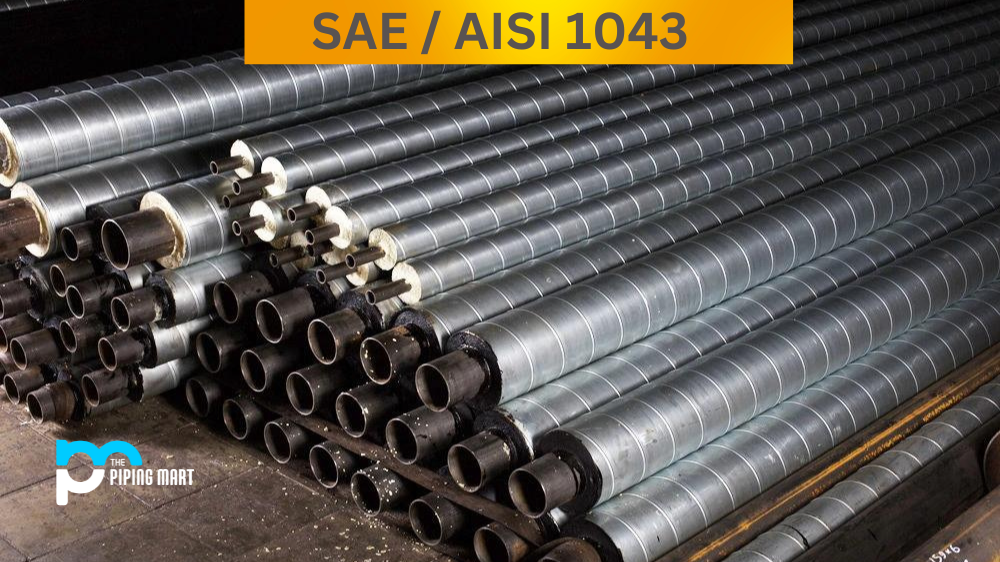In this blog post, we’ll be taking a look at SAE / AISI 1043 – a popular steel alloy used in a variety of applications. We’ll cover some of the most important properties of this alloy, as well as its uses, machining, welding, and heat treatment. By the end of this post, you should have a good understanding of what SAE / AISI 1043 is and how it can be used.
AISI 1043 Composition
| Element | Content (%) |
|---|---|
| Iron, Fe | 98.44-98.9 |
| Manganese, Mn | 0.700-1.00 |
| Carbon, C | 0.400-0.470 |
| Sulfur, S | 0.0500 |
| Phosphorous, P | 0.0400 |
AISI 1043 Physical Properties
| Properties | Metric | Imperial |
|---|---|---|
| Density | 7.7-8.03 g/cm3 | 0.2781-0.2901 lb/in3 |
AISI 1043 Mechanical Properties
| Properties | Metric | Imperial |
|---|---|---|
| Elastic modulus | 190-210 GPa | 27557-30458 ksi |
| Poisson’s ratio | 0.27-0.30 | 0.27-0.30 |
1043 Carbon Steel Equivalent
| EU EN |
USA – |
Germany DIN,WNr |
Japan JIS |
France AFNOR |
England BS |
Italy UNI |
Spain UNE |
China GB |
Sweden SS |
Poland PN |
Czechia CSN |
Austria ONORM |
Russia GOST |
Inter ISO |
|||||||||||||||||||
| C45 (1.0503) |
|
|
|
|
|
|
|
|
|
|
|
|
|
|
AISI 1043 Uses
AISI 1043 is a medium carbon steel with good tensile strength and hardness. It can be heat treated to improve its mechanical properties, but this will also make the steel more difficult to weld. This alloy is often used in the following applications:
- Automotive components
- Construction Equipment
- Machinery parts
- Transmission shafts
- Gears
- Crankshafts
- Knives
- Hammer’s heads
- Anvils
Welding and Machining
SAE 1043 can be both welded and machined, but it is important to note that this alloy will become harder and more difficult to weld if it is heat treated. If you do need to weld SAE / AISI 1043, preheat the steel to 400 degrees Fahrenheit (200 degrees Celsius) before beginning the welding process. When machining this alloy, use sharp tools and plenty of lubrication to prevent tool wear.
Corrosion Resistance
The Grade 1043 steel alloy is renowned for its excellent corrosion resistance, making it an ideal choice for many industrial and engineering applications. Not only does it defend against rust and oxidation damage, but in most cases, it will also tolerate saltwater contact without suffering any appreciable degradation. This formability has made it perfectly suited for use in parts exposed to high levels of moisture and abrasive materials, like diesel motors, off-road equipment, lawnmowers, and agricultural machinery. Furthermore, its machinability qualities mean that production cycles can be quickly optimized with minimal time and cost implications. All these benefits emphasize why SAE / AISI 1043 steel is such a widely used material across a range of industries.
Heat Resistance
Alloy 1043 h AISI 1043 heat-resistant steel is a popular option when it comes to components that must withstand high temperatures. It has exceptional strength and toughness, even at higher temperatures, making it ideal for many situations. This grade of steel can be altered to meet specific requirements, offering improved properties and increased hardness. Thanks to its resistance to stress-related cracking and susceptibility to weldability, it also provides superior welding performance over other types of steel. As an added bonus, the oxidation resistance capability is greater than most materials in its category, which further highlights its heat-resistant qualities.
Heat Treatment
SAE / AISI 1043 can be heat treated to improve its mechanical properties. Common heat treatments for this alloy include annealing, normalizing, quenching, and tempering. Annealing involves heating the steel to between 870 and 900 degrees Fahrenheit (460 and 480 degrees Celsius), holding it for a period of time, and then slowly cooling it in order to relieve stress and improve ductility. Normalizing involves heating the steel to between 950 and 1050 degrees Fahrenheit (510 and 565 degrees Celsius), holding it for a period of time, and then slowly cooling it in order to improve machinability. Quenching involves heating the steel above its critical temperature (between 1475 and 1525 degrees Fahrenheit, depending on carbon content), then cooling rapidly in order to harden the steel. Tempering involves heating the quenched steel to between 350 and 1200 degrees Fahrenheit (175 and 650 degrees Celsius), then cooling at room temperature in order to improve toughness while reducing brittleness.
Conclusion
SAE / AISI 1043 is a versatile medium carbon steel with good tensile strength and hardness. It can be heat treated for improved mechanical properties, but this will also make the steel more difficult to weld. This alloy is often used in automotive components, construction equipment, machinery parts, transmission shafts, gears, crankshafts, knives, hammerheads, anvils, etc. It can be both welded and machined using sharp tools and plenty of lubrication; however, if welding is necessary, it’s important to preheat the steel first. Heat treatment can improve the mechanical properties of SAE / AISI 1043; common heat treatments include annealing, normalizing, quenching, and tempering. With all of these considerations in mind, SAE / AISI 1043 is a great choice for a variety of applications.

Abhishek is a seasoned blogger and industry expert, sharing his insights and knowledge on various topics. With his research, Abhishek offers valuable insights and tips for professionals and enthusiasts. Follow him for expert advice on the latest trends and developments in the metal industry.




